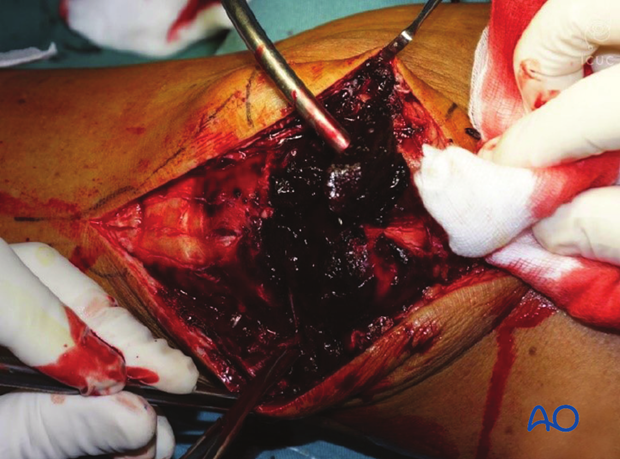Cerclage compression suture
1. Principles
Treatment goals
The patello-femoral joint is biomechanically very stressed when the knee is loaded. Any compromise of the joint surface is likely to lead to degenerative joint disease. It is, therefore, highly desirable, in patellar fractures to strive for anatomical reduction of the joint surface and stable fixation.
In wedge or multifragmentary complete articular fractures, anatomical reduction of the joint surface in relation to all the fragments, combined with durable restoration of the integrity of the extensor mechanism is not commonly achievable.
K-wires with heavy sutures applied in standard cerclage compression configuration (previously called a “tension band”) draw the fragments together as anatomically as possible and permit controlled quadriceps rehabilitation in the medium to late healing phases.
The joint surface commonly heals with some irregularity, predisposing to secondary degenerative joint disease.
An additional treatment goal is restoration of function of the knee extensor mechanism to allow early range of motion of the knee.
Cerclage compression principles
The forces produced by the quadriceps on patellar fractures are significant and may cause early fixation failure. For example, screw fixation alone would generally fail. The physiological forces acting on the patella tend to distract the fragments, more on the anterior than at the posterior aspect.
The cerclage compression technique can be used in all fracture patterns.
This cerclage compression construct was previously called a “tension band”. More information about the tension band principle can be found here.

To be successful, the ventral cortex must be reconstructable.
Often the posterior articular surface is less injured than the dorsal anterior surface and so the cerclage compression suture will work nicely to obtain fracture union.

2. Patient preparation and approach
Patient preparation
This procedure is normally performed with the patient in a supine position with the knee flexed 30°.

Approach
For this procedure a mid-axial longitudinal approach is used.

3. Reduction and K-wire insertion
Debridement
The knee joint and fracture lines must be irrigated and cleared of blood clot and small debris to allow exact reconstruction.

Reduction
Reduce the major fracture fragments using a pointed bone reduction forceps or tenaculum. Transverse fractures are more easily reduced with the leg in extension and sagittal fractures are more easily reduced with the leg in flexion.

Verification of reduction
Anatomical reduction of the articular surface is monitored by palpating the joint from inside, as neither inspection nor the x-ray will reveal a minor step off. This will require creation of a small arthrotomy.
Nevertheless, an image intensifier or X-ray images should always be available, so that the reduction can be checked in the AP and lateral planes if needed.

K-wire insertion
Using the outside-in technique, drill the first K-wire in an axial direction. The second K-wire is then drilled parallel to the first, through the reduced fragments ensuring the K-wires do not enter the joint. It may be difficult to find the right direction and position for the wires. The direction is verified by lateral imaging.
Two parallel K-wires should be inserted to give more stable fixation.
Reduction is again verified by palpation of the joint surface.

4. Suture insertion
Insert a nr. 5 Ethibond non-absorbable suture in a figure-of-eight fashion.
Push the suture as close as possible to the angle between the bone and the protruding K-wire tips.
The suture should be as close as possible to the bone throughout its whole course both superiorly and inferiorly.

Applying the figure-of-eight suture
While tightening the figure-of-eight suture with the knee in extension, check the reduction by palpating the retropatellar surface (this will require creation of a small arthrotomy).
Once the suture is tightened, a second suture is placed. Care is taken not to damage the first suture with the sharp needle.
After tightening the figure-of-eight suture, bend the proximal pin ends, shorten them, turn them towards the quadriceps tendon, and drive them into the patella to prevent skin irritation and loosening.
The distal pin ends are trimmed to remove the sharp points, but not bent, for easier removal.

Additional stabilization
Further stabilization may be achieved with the addition of cerclage suture/wire and/or lag screws.

5. Aftercare following cerclage compression wiring/lag screw/plate fixation of the patella
Introduction
Active knee function requires an intact knee extensor mechanism, a mobile patella, a well-preserved patello-femoral joint and muscle strength.
After satisfactory reduction and fixation of patellar fractures, early controlled range of motion exercises are combined with static quadriceps strengthening exercises. The progressive increase in loading of the patello-femoral joint depends on many factors and requires planned individual programs, designed by the surgeon and physical therapists.
Functional treatment
Patellar fixation is generally quite stable. Early progressive, active mobilization is beneficial after surgery. Despite, wearing a splint to protect against never losing complete extension, range of motion is done throughout the day with the splint off. Static isometric quadriceps exercises should be started on postoperative day 1 with the splint in place. Usually the anterior incision is slow to heal as it is over a flexion surface and so it is usually best to leave the knee in extension for at least a week.
Afterwards, special emphasis should be given on active knee and hip movement.
Weight bearing
A removable full extension knee splint is applied and worn until good quadriceps control is regained. Full weight bearing may be performed with a straight knee, using crutches or a walker, from postoperative day 1.
Follow-up
Wound healing should be assessed regularly during the first two weeks. X-rays should be taken at 2, 6 and 12 weeks. A longer period may be required if fracture healing is delayed.
Implant removal
Implant removal may be required, as the wires may be prominent under the skin. Implant removal should not be undertaken until a minimum of 1 year postoperatively.
Thrombo-embolic prophylaxis













